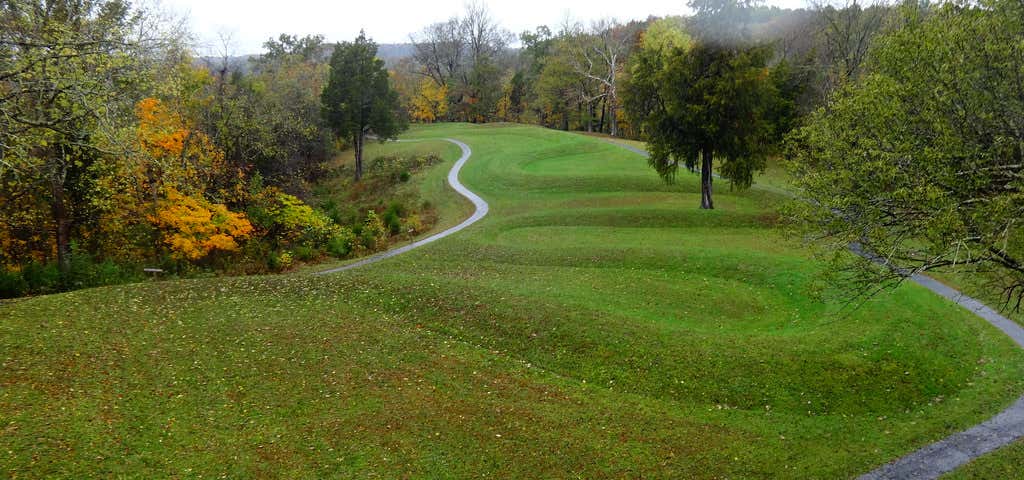Ohio might seem like a state filled with farms and cornfields, and not much else, but hidden among the rolling pastures and crops, you might find some pretty strange ancient ruins. Native Americans were drawn to Ohio, and in the same way that the Pueblo Indians built dwellings into the cliffs of mesas, the tribes who settled in the Buckeye state left their mark on the land. Earthworks and mounds are all that remain of the ancient peoples who occupied the land long ago. The mounds are often incredibly sophisticated, laid out in the shapes of animals, or in patterns that correspond with the sun or the stars, and sometimes filled with artifacts or even bodies. Here are a few of the most fascinating and mysterious ancient ruins across Ohio!
Fort Ancient State Memorial
Fort Ancient is a massive settlement of the Hopewell tribe, who lived in the area between the 1st century BC and the 6th century AD. They built three and a half miles of earthworks walls, enclosing a 100-acrea hilltop. Long after it was built, the Fort Ancient peoples moved into the area (I know, confusing). Wandering the enclosure, it's incredible to think that the mounds were made using bones and shells and baskets. Scholars suspect that the walls were built with gaps that align with solar and lunar events, and that the space was social and ceremonial, not defensive or protective. There's also a museum onsite that provides extra insight into the people who built these walls, lived here later, and how the site has been excavated.
By far one of the most mysterious ancient sites in Ohio, Serpent Mound is a 1,348-foot-long earthen snake effigy. Scientists haven't been able to conclusively date the mound, with some thinking that the Adena culture built it in 300 BC, or that the Fort Ancient peoples constructed it in 1050 AD; they do agree that the head, tail, and coils align with solstices, equinoxes, and lunar patterns (and maybe even constellations and comets!) Things get even weirder, too; it's built on the site of an astrobleme, an ancient meteorite impact site... even though there's no way that the tribe that built it would have known that. The museum onsite provides information on the construction and significance of the massive snake.
The Hopewell tribe lived in the Ohio River Valley, near present-day Chillicothe, and even though they only occupied the area between 200 BC and AD 500, they were incredibly prolific mound builders. The Hopewell Culture National Historic Park preserves six separate sites with earthworks, including the incredible Mound City complex, which contains 23 mounds enclosed within a 13-acre area, surrounded by 3-4 foot walls. Walls in the shapes of circles and squares, and even burial mounds, can be found across the park. Some reconstruction has been done to keep the mounds looking as they did when they were built, and they're being carefully preserved.
Flint Ridge State Park
Flint Ridge, in Licking County, was an important site to many Native American tribes in Ohio. The quarries here contained brightly colored flint, which was used to make tools, especially arrowheads, which were vital to the survival of these hunters, and ignite fires. It was also valuable for trade. As you walk the trails, you can see pits from where the flint was quarried, and you can see inside one within the museum. It also displays artifacts, talks about the formation of flint, and demonstrates how it was used.
Quadranaou Park
The city of Marietta is virtually built atop a complex of mounds built by the Hopewell. Early settlers gave the mounds Latin names, like Sacra Via, Conius, Capitolium, and Quadranaou. Quadranaou was likely built in 900AD or so, and both Quadranaou the Sacra Via were part of Camp Tupper during the Civil War. Some consider the mounds to be haunted; perhaps a Hopewell Indian, or maybe a Civil War soldier.
Explore More Trip Guides
A holly, jolly road trip to holiday movie filming locations
- 9 Places
- 57:06
- 3,562 mi
The ultimate road trip guide to I-90, from Boston to Seattle
- 47 Places
- 60:51
- 3,500 mi







